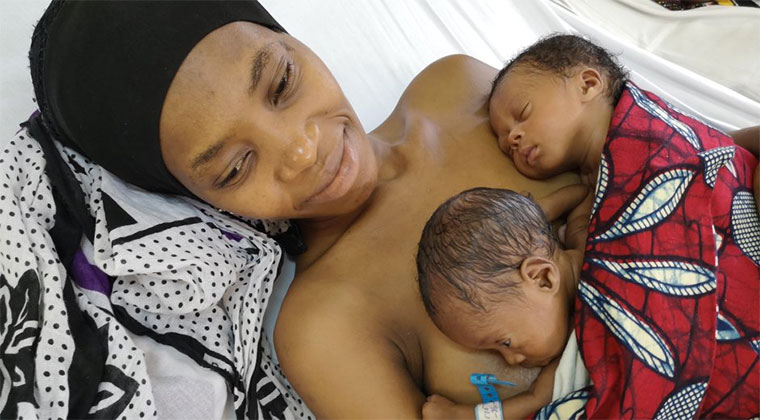This blog was originally posted in The Observer on May 15, 2019.
Saidah, a mother of twins who were born preterm, would never have imagined that such tiny babies weighing 1.2 and 1.6 kilogrammes would survive.
It was a first experience for her. She was, however, surprised that as time passed, her babies grew bigger. For that, Saidah and her husband Mawazi will forever be grateful to the health workers of the special care unit at Jinja regional referral hospital who gave them hope, as I found out this week in a quick catch-up phone chat.
Saidah’s babies are among the nearly 3,000 prematures that were followed up under Makerere University’s Ending Preterm Birth Initiative (PTBi) study which sought to improve the survival of babies born before term across six hospitals (Jinja, Iganga, Bugiri, Buluba, Kamuli General and Kamuli Mission) in Eastern Uganda over the last three years.
The twins were discharged from hospital in under two weeks and Saidah was instructed to practice Kangaroo care (KC), without fail. KC is a method of caring for a baby, especially one who is premature, that emphasizes the importance of holding the naked or partially dressed child against the bare skin of a parent (in the chest), typically the mother, for as long as possible each day. It also involves frequent and exclusive breastfeeding, as well as early discharge from hospital once the babies are stable.
As we commemorate the 2019 International Kangaroo Mother Care Awareness day today (May 15), Saidah’s babies are testimony that kangaroo care can save premature and low-birth-weight babies.
According to the World Health Organisation, there is evidence suggesting that kangaroo care is a safe and effective alternative to conventional neonatal care, especially in under-resourced settings and may reduce disease and death of infants such as Saidah’s, as well as increase in breastfeeding.
However, it is all not rosy and as easy as it sounds. Challenges still abound in Uganda. Data on uptake is old with a 2012 assessment of KC coverage in Uganda indicating low uptake. It showed KC only being practiced in Kampala and in 17 health facilities in total.
As we learnt from implementation in the early days of PTBi and systematic reviews, families/communities and health workers/system are having their challenges as well.
Given the time and energy demands of KC, the practice is cumbersome for mothers recovering from childbirth let alone the biased gender assignments that leave them overwhelmed, the stigma and cultural demands that leave them confused. On the side of health workers, low staffing numbers stretch them, but there is also a sizeable number that has not been trained and, therefore, can’t educate and help mothers.
To bridge the knowledge gap, PTBi trained over 200 midwives and nurses from maternity wards, special neonatal care units (SCU) and paediatric wards of the six hospitals in the care of sick and small/preterm babies particularly in KC to maintain warmth and feeding.
Bedsides, mentorship of medics was carried out on a quarterly basis in the SCU using both national and regional level paediatricians and neonatologist in order to impart skills and competencies of nurses to offer appropriate care of the sick and small babies.
Consequently, kangaroo care practice improved from about 55 percent to 100 percent in two years and has become a routine for all eligible preterm/small newborn babies in the main six hospitals in the Busoga sub-region.
Nonetheless, as government embarks on a countrywide rollout of essential newborn care to which KC is part, a couple of things need to be done. There is need for strategic communication efforts to get family and community buy-in of kangaroo care which comes with stigma and stress.
Training of health workers and creating of a suitable environment for initiation and practice of KC in health facilities cannot be underestimated.
This calls for dedicated funding and requisite policies and guidelines. This way, many if not all, of Uganda’s nearly 10,000 premature babies (of the estimated 226,000 born yearly) who die annually, could be saved through this simple practice of kangaroo care.

